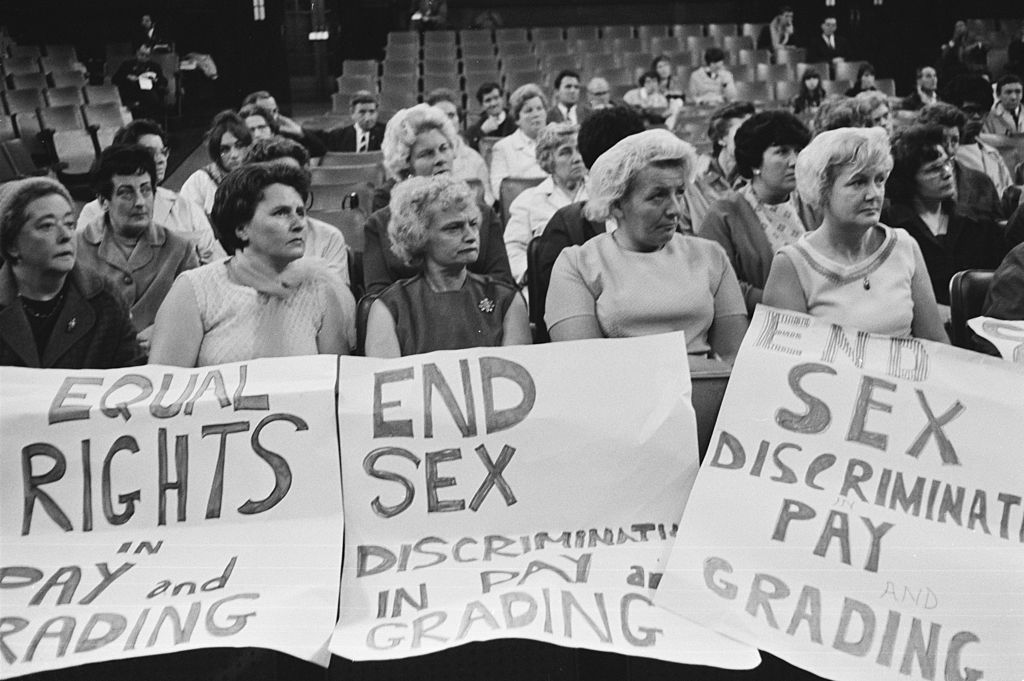When you think of 1972, what comes to mind? Corduroy flares, President Nixon and the first installment of The Godfather? Or bra-burning, feminist “consciousness-raising” meetings and debates about abortion and birth control?
America in the early 1970s was not just a nation of Vietnam War vets and oil crises, but one of significant feminist liberation. Betty Friedan published The Feminine Mystique in 1963 and helped found the National Organization for Women in 1966, and the decade after saw a whole host of similar organizations, such as the Women’s Radical Action Project (WRAP) and the catchily named Women’s International Terrorist Conspiracy from Hell (WITCH).
It was into this radical hair-growing, hell-raising context that Ira Levin published his novel, The Stepford Wives (1972) — half a century ago this year. Even without having read the book, most people will be familiar with Levin’s premise, if not his plot. A “Stepford Wife” has become a byword for identikit, glamorous, flower-arranging, housewifely perfection.
The fact that the women in Levin’s novel have been altered into un-thinking, un-complaining robots against their will seems to have passed many people by: Melania Trump was repeatedly compared to Levin’s fictional creations, while the British newspaper the Sun managed to find a group of women who self-described as happy “Stepford wives.”
Levin’s novel attracted more attention when it was made into a film in 1975 directed by Bryan Forbes. The film — despite some significant issues — did very well: its soundtrack and slow-moving pace took Levin’s horror to new heights, while Katharine Ross played the curious, constrained Joanna Eberhart with admirable poise.
The screenplay is a stilted letdown: William Goldman (the novelist responsible for the cult classic The Princess Bride) lifts whole lines and passages verbatim from a novel that, despite its retrospective fame, is hardly remembered for its prosodic brilliance.
But Betty Friedan’s issue with the film was not its jilted dialogue. At a screening in New York for “100 women opinionmakers,” Friedan only lasted ten minutes before saying, “I think we should all leave here. I don’t think we should help publicize this movie. It’s a rip-off of the women’s movement.” She then left, with three women trailing her. The author and screenwriter Eleanor Perry echoed her with the comment, “Men made this film, right?”, while another writer, Linda Arkin, summed it up with, “It confirms every fear we’ve ever had about the battle of the sexes.”
The issues with the film’s interpretation of the book are manifold: Forbes alters Joanna’s interaction with the psychiatrist so there is none of the nascent gas-lighting, and, at its climax, it becomes clear that the robots cannot bleed — a moment of ambiguity flattened from in the novel.
But these feminists’ reactions were less of the nit-picking variety: The Stepford Wives, on either the page or the screen, fails to do justice to the movement it proclaims to be inspired by. Kate Millett, Betty Friedan — both are name-dropped in the book. Joanna and Bobby want to set up their own feminist group and are surprised to discover that a former women’s association had been shut down.
But rather than making these issues interesting or accessible, Levin — and Forbes — sensationalize them. The women’s liberation movement is just one side of the horror-movie coin. In this world, campaigning for feminist awareness leaves a woman with less freedom than when she started.
Fifty years on, this issue with the book and film is no less thorny. It is uncomfortable, to say the least, that Levin’s novel has been circulated more than genuinely feminist works from second-wave feminism like Millet’s Sexual Politics (published just two years before Levin’s book), Pat Mainardi’s The Politics of Housework (1970), or Hélène Cixou’s The Laugh of the Medusa (1976).
Levin wrote his work as the backlash against second-wave feminism was beginning. The Equal Rights Amendment was reintroduced in 1971 — and made its way through the Senate in 1972 — but failed to achieve ratification in the decade that followed. After the oil crisis in 1973, political conservatism began to gain ground. Levin’s science-fiction horror was extreme, but it didn’t come out of nowhere.
And it is here that, half a century on, we might have to begrudgingly acknowledge what Levin got right. While the film was remade (starring Nicole Kidman) to have a “woman-in-charge” ending in 2004, it was an undeniable, shocking flop that failed with critics and box office numbers alike. Rather than being an unwanted and false prophet of doom, Levin’s vision of the science-fiction future might be more accurate than we would like to believe.
Levin satirized men’s desire for sexually complicit automatons — and we now live in an age of increasingly accessible violent pornography that is not limited to the virtual world screens. Girls and women are being choked and strangled during sex against their will as a result of the pornography boys are watching; face-slapping, gagging and spitting have become all the rage.
In the place of genuine philosophy or attempts at radical change, we have their empty, performative cousins. Feminism is now something that can be achieved on social media, where an unaltered selfie is somehow the pinnacle of bravery, and “girl bosses” like Kim Kardashian and Kylie Jenner are hailed as feminist, hard-working icons. Instead of fighting against real oppression, women launch themselves into crusades against filters on Instagram, or spend time debating whether Will Smith’s slap was “chivalry gone wrong.” And all the time, women are being raped, abused and routinely discriminated against in every field from healthcare to the workplace.
Half a century on from President Nixon, we still haven’t had a female president. Joanna Eberhart — before she lost her brain to robot-hood — would be disappointed. So, as much as it pains me to say, The Stepford Wives still deserves to be read. But, please, please pick up Sexual Politics while you’re at it.

























